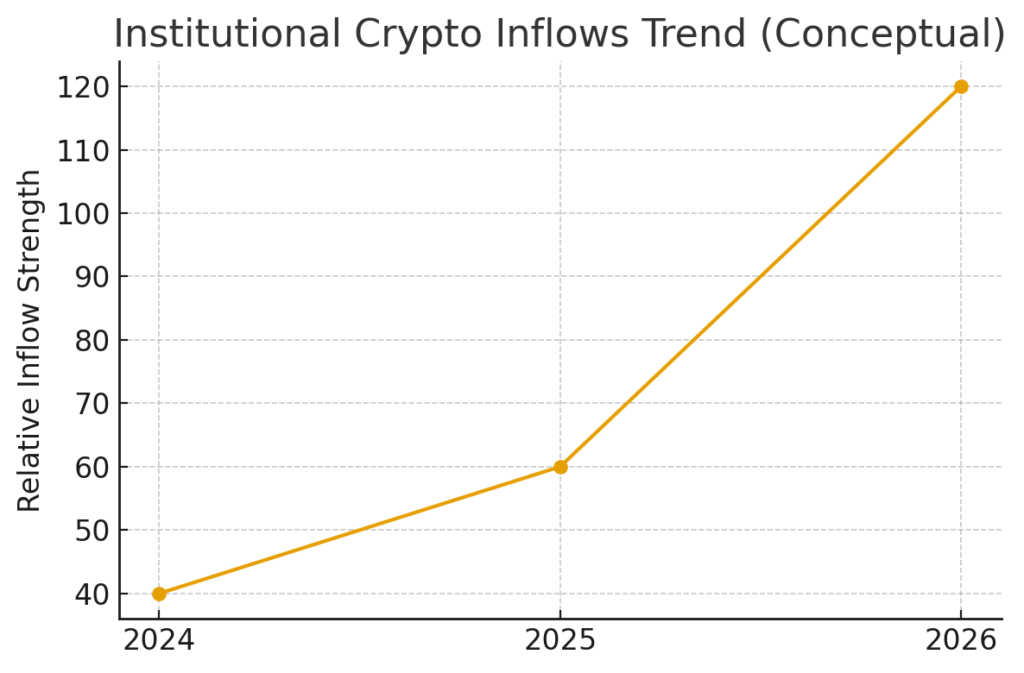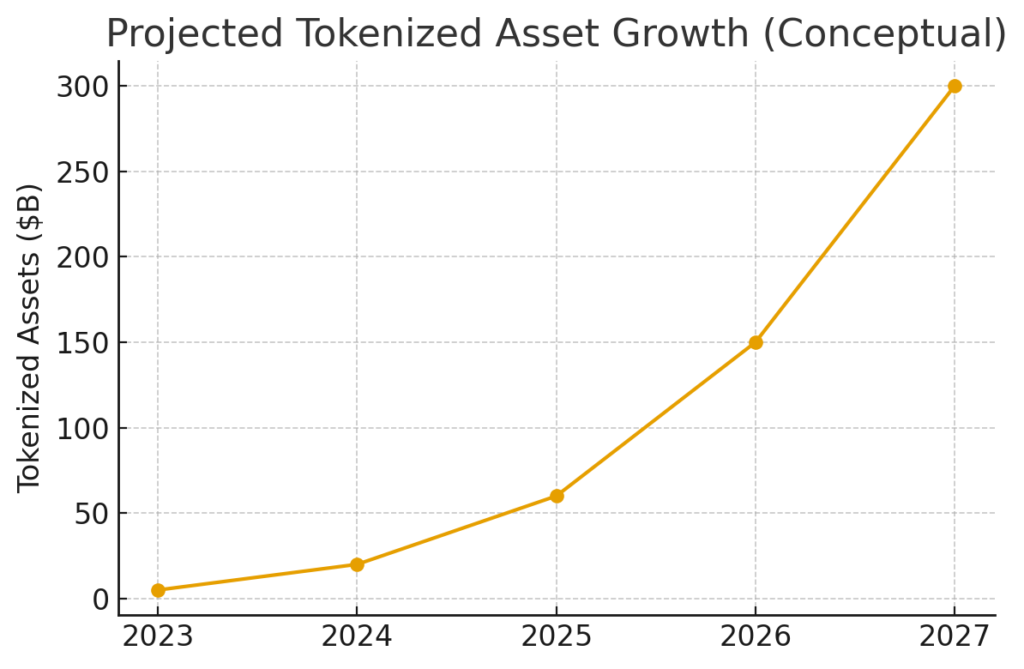
Main Points :
- Institutional adoption, regulation, stablecoins, and tokenization are forming the strongest fundamental base in crypto history.
- Bitwise CIO Matt Hougan predicts that 2026—not 2025—will be the true bull market year due to the absence of a final 2025 surge.
- Retail “crypto-native investors” remain discouraged, but traditional finance investors (especially ETF buyers) continue to enter the market.
- BTC, ETH, and SOL are projected to hit new all-time highs by 2026, though forecasts are more conservative than the extreme predictions of Arthur Hayes and Tom Lee.
- Stablecoin growth, Bitcoin debasement trades, and renewed interest in DeFi (e.g., Uniswap fee switch proposal) are strengthening the bullish outlook.
- Data suggests a major rotation: short-term retail weakness but rapidly strengthening institutional appetite.
Introduction: A Market Waiting to Ignite
The global cryptocurrency market stands at a pivotal moment. Despite the lack of a powerful rally in late 2025—something many investors anticipated—Bitwise CIO Matt Hougan argues that this absence is precisely what sets up 2026 to become a historic bull market year. Hougan’s view, backed by macro data, institutional flows, regulation, and rapidly expanding stablecoin usage, points to a cycle unlike any before it.
During an interview at the “The Bridge” conference in New York, he highlighted that crypto’s traditional 4-year cycle would normally peak in 2025, followed by a downturn in 2026. However, “the rally didn’t happen” in 2025.
Because of that, the explosive upside commonly expected in year 3 of the cycle is now delayed—and building pressure.
This article synthesizes Hougan’s remarks, additional market data, and recent developments across global crypto markets to provide a comprehensive outlook for investors searching for new digital assets, yield opportunities, and practical blockchain applications.
1. Why 2026 Is Becoming the New “Cycle Peak Year”
1.1 The Missing 2025 Rally Changes Everything
Hougan argues that if Bitcoin had already surged aggressively by late 2025, 2026 would likely resemble previous downturn years (like 2018 and 2022).
But that didn’t happen. Prices rose, but the euphoric breakout—driven by FOMO, liquidity, and mass speculation—was absent.
Instead, the market saw:
- A modest appreciation in BTC
- Sideways accumulation in ETH
- Rotation out of some altcoins
- Pauses in institutional inflows
The absence of a manic rally preserved significant unrealized demand.
Thus, rather than entering the decline phase of the cycle, the market is actually delayed in approaching its peak.
This sets the stage for 2026 to become the real explosive year.
2. Fundamentals Have Never Been Stronger
Hougan emphasizes that the underlying fundamentals of crypto are extraordinarily robust:
2.1 Institutional Adoption Is Accelerating

Since 2023, traditional finance (TradFi) institutions have shown consistent crypto appetite.
The approval of Bitcoin spot ETFs opened a floodgate, and inflows into those ETFs have continued for more than two years.
2.2 Regulatory Clarity Is Increasing
Across the U.S., EU, UAE, Hong Kong, Singapore, and Japan, regulators are modernizing crypto frameworks.
This contrasts sharply with the regulatory uncertainty of past bull runs.
2.3 Stablecoins Are Becoming a Global Financial Rail
Stablecoin settlement volumes now rival—and in some markets exceed—Visa.
USDC and USDT are moving across borders at unprecedented scale, becoming the default rails for remittances, trading, and on-chain commerce.
2.4 Tokenization Is Finally Going Mainstream
Several trillion dollars of real-world assets (RWAs) are projected to be tokenized by 2030.
Major banks—Citi, JP Morgan, Standard Chartered—are already building tokenization platforms.
2.5 DeFi May Rise Again with Uniswap’s Fee Switch
The Uniswap proposal to activate its fee switch (redistribution of fees to UNI holders) is viewed as a catalyst that may revive investor interest in DeFi.
3. Bitcoin, Ethereum, and Solana: Outlook to 2026
Hougan is bullish on all three top networks:
- Bitcoin (BTC) — supported by debasement hedging and institutional flows
- Ethereum (ETH) — strengthened by tokenization and scaling upgrades
- Solana (SOL) — rapidly becoming the execution layer for high-throughput decentralized apps (dApps)
However, he remains more conservative than high-profile forecasters Arthur Hayes and Tom Lee.
3.1 Hayes/Lee Extreme Forecasts
Both forecast the following levels by late 2025:
| Asset | Current Price | Hayes/Lee Forecast | Required Gain |
|---|---|---|---|
| BTC | $101,762 | $250,000 | +145% |
| ETH | $3,416 | $15,000 | +340% |
Hougan does not expect such extreme moves in such a short period.
But he does expect new all-time highs—just on a more realistic timeline that peaks in 2026.
4. Investor Sentiment: A Market Divided

There is now a clear divide between two categories of investors:
4.1 Crypto-Native Retail Investors Are Discouraged
Hougan notes that “crypto-native individual investors are despondent.”
They have been hit by:
- FTX collapse
- Meme token crashes
- Absence of a broad altcoin season
- Massive liquidations (e.g., October 10 event)
- Slow performance in once-popular assets
Many early adopters have sold aggressively, limiting upside in 2025.
4.2 Traditional Finance Investors Are Entering the Market
In contrast, traditional investors (typical ETF buyers) are accelerating their crypto allocation.
These include:
- High-net-worth individuals
- Professional wealth managers
- Conservative long-term investors
- New retail ETF buyers
- Family offices
Hougan even cites personal anecdotes, such as his uncle entering crypto for the first time through ETFs.
Thus, even as early adopters pull back, “TradFi retail” is fueling the next wave.
5. Additional Global Developments Shaping the 2026 Bull Market
To provide context beyond the original interview, here are additional trends that support the 2026 thesis:
5.1 U.S. Rate Cuts Will Increase Liquidity
Most economists anticipate U.S. rate cuts beginning late 2025 and extending into 2026.
Lower rates historically boost risk assets—including crypto.
5.2 Halving Effects Typically Peak 12–18 Months Later
Bitcoin halving cycles have historically peaked:
- 2013 → 14 months later
- 2017 → 17 months later
- 2021 → ~18 months later
The 2024 halving therefore points naturally toward mid/late 2025 — early 2026.
5.3 Ethereum Upgrades Strengthen Utility
With EIP-4844 and future Danksharding steps, Ethereum is becoming cheaper and more scalable—improving institutional comfort.
5.4 Real-World Stablecoin Demand Soars in Asia

Southeast Asian markets—Philippines, Vietnam, Indonesia—are among the fastest adopters of USDC for remittances and e-commerce.
5.5 Solana Has Become the Fastest Growing Developer Ecosystem
Solana transactions, active wallets, and new dApps have surged since 2024, positioning it as a serious competitor to Ethereum for consumer-grade apps.
6. What This Means for Investors Searching for New Crypto Assets
With fundamentals strong and sentiment divided, 2026 may offer a rare investment environment:
6.1 Large-Cap Opportunities
BTC, ETH, and SOL remain strong candidates for stable long-term growth.
6.2 Emerging Tokens
Tokens tied to:
- Real-world asset tokenization
- Stablecoin infrastructure
- Layer-2 scaling
- DeFi revenue models
- Payments and settlement systems
may see explosive adoption.
6.3 Institutional-Friendly Assets
ETF-eligible assets or those with clear regulatory frameworks will likely absorb the largest capital inflows.
Conclusion: The Quiet Before the Storm
While many investors feel frustrated by the slower pace of 2025, the structural setup for 2026 is exceptionally strong.
Institutional adoption, regulatory clarity, expanding stablecoin usage, and improving blockchain infrastructure underpin Hougan’s conviction that 2026 will mark the true bull market peak of this cycle.
If this forecast proves correct, the current market represents a rare moment of accumulation before global liquidity, institutional demand, and technological maturity converge into one of the strongest crypto cycles ever seen.

